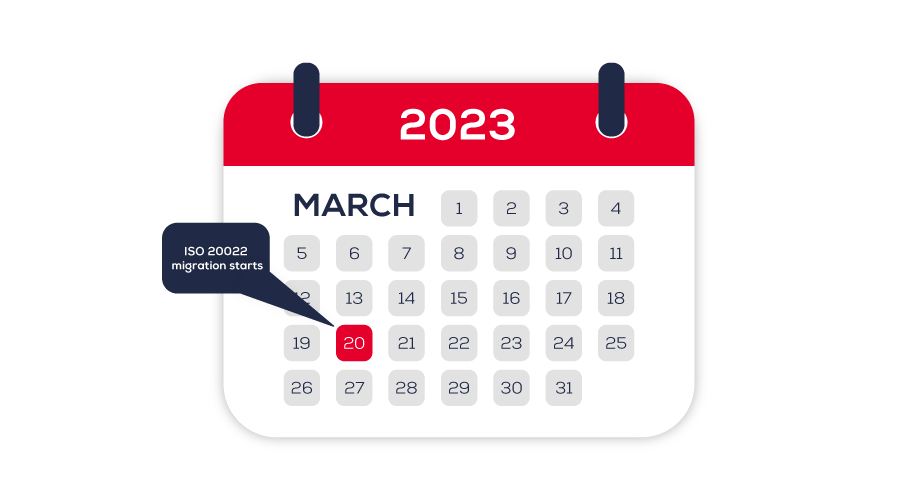Initially scheduled for the end of November 2022, the start of banks’ migration to the ISO 20022 standard for payments has been postponed by a few months. Rather than just being something new to comply with, the standard will enable banks to provide new services to businesses thanks to the enriched information that this payment format involves, and there will also be big benefits for corporate. Here’s what we found out about ISO 20022 during SIBOS in Amsterdam last October.
Last autumn, the ECB announced its decision to delay the Euro system’s migration to the new ISO 20022 messaging standard by four months to ensure that the transition to the new platform will be smooth. In light of this announcement, Swift committed to further analyze and validate impacts on the timeline for using ISO 20022 in cross-border payments and reporting (CBPR+).
To ensure that operational and business continuity is maintained across the global financial system, Swift has aligned the start of the global ISO 20022 migration for CBPR+ with the ECB’s updated timetable. As such, the period of coexistence between the ISO 20022 and MT messaging standards for all users will begin on March 20, 2023.
At this date, banks will start to move all of their cross-border payments messages to the ISO 20022 financial messaging standard, whose messages are more highly structured and data-rich than the previous format. The coexistence period between the two standards will end in November 2025, when MT messages will be removed. Banks are free to adopt the new format at their own pace between March 2023 and November 2025. In the meantime, in-flow translation tools will help them to receive messages in the format of their choice.

What are the implications of the the migration to ISO 20022?
At first glance, it might seem like corporates don’t need to worry about the migration to ISO 20022 as they are not involved in the interbank space. What’s more, they already have the choice to send payment messages in MX format or via FileAct for large ISO files.
But that’s not the full picture. The migration does have implications for corporates, as ISO 20022 could improve the efficiency of the interactions between their treasury, accounting, sales and purchasing departments. And the richer data within ISO 20022 messages could also lead to enhanced bank reconciliation, cash forecasting and payment efficiency for corporates.
For banks, the ISO 20022 migration is much more than a compliance issue. It represents an opportunity for them to develop compelling business cases for their clients.
The financial industry is still in the process of identifying all the potential use cases that ISO 20022 messages will lead to by exploiting synergies with real-time payments and modernized payment infrastructures. At SIBOS, Deloitte presented two potential use cases for the new standard during a workshop: one for the insurance industry, the other for small businesses.
Insurance industry use case: better processing of insurance claims
This use case is linked to the processing of an insurance claim, all the way from filing and approving the claim to paying the check and performing account reconciliation. At the present, it generally takes between 5 and 15 days to receive payment after making a claim. What’s more, making entries manually throughout the process might lead to errors, and the overall cost of processing a check is between $20–$30. This can be reduced by $10 by using the ISO 20022 system as reconciliation is easier and there is no need to issue and post a check.
With ISO 20022 embedded in the app dedicated to claim direct deposits, the customer can follow the approvement process in real time and is notified when the payment is received. For this to be possible, the bank must be able to provide real-time payment APIs to the insurer through the relevant ERP, ensure there are real-time controls on fraud and anti-money laundering, and send real-time acknowledgement messages along with structured remittance data. In this case, ISO 20022 is used on the reconciliation side of the transaction.
Small business use case: installment payments
This use case considered the benefits of linking a web-based ordering platform to ISO capabilities, with a QR code proposing different types of payments based on the remittance information. Banks could generate additional business by providing funding or additional offers to their clients based on the clearer view of their business that ISO 20022 messaging results in.
Corporates need to invest in ISO capabilities so that they can accept required data from their customers as well as achieve increased automation through end-to-end processing and reconciliation of payments. They also need to invest in additional digital capabilities. When combined with ISO 20022, these investments will result in significant benefits for their customers, such as QR-embedded invoicing and the ability to track the progress of their orders online. There will also be benefits for corporates, such as significant cost savings through shifting from manual-intensive to automated reconciliation and optimized treasury operations.
